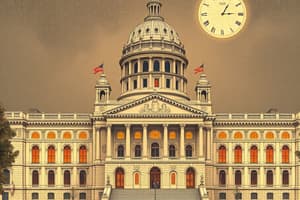Podcast
Questions and Answers
What is the primary reason for redistricting in the United States?
What is the primary reason for redistricting in the United States?
- To reflect changes in voter demographics
- To adjust district boundaries based on population changes (correct)
- To create more competitive congressional elections
- To ensure equal representation for all citizens
What happens to the representation of states in the House of Representatives?
What happens to the representation of states in the House of Representatives?
- States with larger populations have more representatives in the House. (correct)
- Each state has the same number of representatives, regardless of population.
- The number of representatives for each state is determined by the number of senators they have.
- The number of representatives for each state is fixed and never changes.
Which of the following is NOT a factor that influences congressional elections?
Which of the following is NOT a factor that influences congressional elections?
- The political climate and national issues
- The boundaries of electoral districts
- The number of registered voters in each state (correct)
- The candidates' campaign strategies and fundraising
What is the main difference between constituencies in the House of Representatives and the Senate?
What is the main difference between constituencies in the House of Representatives and the Senate?
Why is the redistricting process often considered controversial?
Why is the redistricting process often considered controversial?
What is one of the key arguments against gerrymandering?
What is one of the key arguments against gerrymandering?
How many members are there in the House of Representatives?
How many members are there in the House of Representatives?
How often are congressional elections held for the House of Representatives?
How often are congressional elections held for the House of Representatives?
What is the main goal of partisan gerrymandering?
What is the main goal of partisan gerrymandering?
What was the significance of the Supreme Court ruling in Baker v. Carr (1962)?
What was the significance of the Supreme Court ruling in Baker v. Carr (1962)?
What is the main argument against Malapportionment?
What is the main argument against Malapportionment?
What is the main takeaway from the Supreme Court ruling in Shaw v. Reno (1993) regarding racial and ethnic considerations in drawing district boundaries?
What is the main takeaway from the Supreme Court ruling in Shaw v. Reno (1993) regarding racial and ethnic considerations in drawing district boundaries?
What is the main advantage that incumbents possess in congressional elections?
What is the main advantage that incumbents possess in congressional elections?
Why is the incumbency advantage stronger in the House of Representatives compared to the Senate?
Why is the incumbency advantage stronger in the House of Representatives compared to the Senate?
What is the main reason why experience is crucial for successful challengers in congressional elections?
What is the main reason why experience is crucial for successful challengers in congressional elections?
What is the primary reason why money plays a significant role in congressional elections?
What is the primary reason why money plays a significant role in congressional elections?
What privilege do incumbent representatives have that helps them communicate with their constituents?
What privilege do incumbent representatives have that helps them communicate with their constituents?
Why do challengers often wait for open seat elections to run for Congress?
Why do challengers often wait for open seat elections to run for Congress?
What is the primary reason why incumbents typically succeed in congressional elections?
What is the primary reason why incumbents typically succeed in congressional elections?
What is a key strategy incumbents use to enhance their advantage in congressional elections?
What is a key strategy incumbents use to enhance their advantage in congressional elections?
Which tactic is MOST commonly used by incumbents to maximize their resources and discourage qualified challengers?
Which tactic is MOST commonly used by incumbents to maximize their resources and discourage qualified challengers?
Which of these are valid reasons why an incumbent might lose an election? (Select all that apply)
Which of these are valid reasons why an incumbent might lose an election? (Select all that apply)
What is the main reason why congressional races are so expensive?
What is the main reason why congressional races are so expensive?
Compared to House races, Senate races typically cost more. What is the MAIN factor contributing to this difference?
Compared to House races, Senate races typically cost more. What is the MAIN factor contributing to this difference?
What is the MOST LIKELY reason why professional experience is highly valued in congressional candidates?
What is the MOST LIKELY reason why professional experience is highly valued in congressional candidates?
Flashcards
Constituencies
Constituencies
A body of voters in a designated area who elect a representative.
Redistricting
Redistricting
The process of redrawing electoral district boundaries after a census.
Gerrymandering
Gerrymandering
The intentional manipulation of district boundaries to benefit a specific group.
Apportionment
Apportionment
Signup and view all the flashcards
Senate Representation
Senate Representation
Signup and view all the flashcards
House of Representatives Size
House of Representatives Size
Signup and view all the flashcards
District Boundaries
District Boundaries
Signup and view all the flashcards
Bipartisan Commission
Bipartisan Commission
Signup and view all the flashcards
Partisan Gerrymandering
Partisan Gerrymandering
Signup and view all the flashcards
Racial Gerrymandering
Racial Gerrymandering
Signup and view all the flashcards
Baker v. Carr (1962)
Baker v. Carr (1962)
Signup and view all the flashcards
Malapportionment
Malapportionment
Signup and view all the flashcards
Shaw v. Reno (1993)
Shaw v. Reno (1993)
Signup and view all the flashcards
Incumbency
Incumbency
Signup and view all the flashcards
Incumbent Advantage
Incumbent Advantage
Signup and view all the flashcards
Congressional Election Costs
Congressional Election Costs
Signup and view all the flashcards
Franking Privilege
Franking Privilege
Signup and view all the flashcards
Challenges for Incumbents
Challenges for Incumbents
Signup and view all the flashcards
Electoral Majority
Electoral Majority
Signup and view all the flashcards
Experience in Elections
Experience in Elections
Signup and view all the flashcards
Media Coverage
Media Coverage
Signup and view all the flashcards
Challengers' Strategy
Challengers' Strategy
Signup and view all the flashcards
Casework
Casework
Signup and view all the flashcards
Study Notes
Congressional Elections
- Constituencies: Groups of voters electing representatives/senators
- Constitutional Framework: Sets the broad rules for constituencies, but the division process, especially for the House, is often political and controversial
- Senate Representation: Each state has 2 senators; elections are staggered to prevent both seats being up for grabs in the same election
- Unequal Voter Representation: Senators represent states, not individual voters. Wyoming (587,000) and California (39 million) have the same number of senators
- House Apportionment: Determined by population. 435 members since 1929. Changes based on population shifts, recently favoring the South and West
- Redistricting: Redrawing district boundaries following the census. Crucial for House representation
Gerrymandering
- Definition: Intentional manipulation of district boundaries to benefit a specific interest group or party
- Partisan Gerrymandering: Devising district shapes to benefit a specific party. Concentrates opposing party voters in a few districts, making it easier for their party to win.
- Racial/Ethnic Gerrymandering: Creating majority-minority districts, boosting chances for racial/ethnic minority candidates.
- Supreme Court Role: Has ruled that district boundaries cannot be drawn solely or primarily on racial grounds
Gerrymandering and Redistricting
- Baker v. Carr (1962): Supreme Court ruled that each district must have similar populations to avoid malapportionment (unequal distribution)
- Shaw v. Reno (1993): Supreme Court rejected North Carolina reapportionment plan, citing racial gerrymandering (bizarre districts). Allowed race to be a factor but not the primary one.
- Political Considerations: Often high stakes, majority party typically seeks to maintain or increase their advantage.
Incumbency Advantages
- Definition: An incumbent is an office-holder running for reelection.
- Advantages: More media coverage, proven track record, established networks of donors, name recognition
- House vs. Senate: Incumbency advantage is stronger in the House due to shorter terms and usually dominant political parties.
- Reasons for Losing: Scandals, economic downturns, "throw the bums out" sentiment, redistricting
Experience & Money
- Challenger Needs: Challengers need experience and money to compete. Experience typically gained through local/state government.
- Cost of Elections: Congressional races are expensive. In 2016, total election spending was $4 billion
- Senate Race cost averaging $1.5 million and House ~ $500,000.
Maximizing Incumbency
- Franking Privilege: Free mail usage for communication
- Constituent Service: Help constituents with federal and state bureaucracy
- Policy Role Claim: Take credit for Washington actions and policy roles
Studying That Suits You
Use AI to generate personalized quizzes and flashcards to suit your learning preferences.




